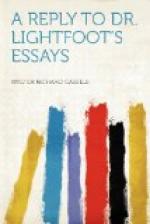I turn, however, to a more important matter. Canon Lightfoot attacks me in no measured terms for a criticism upon Dr. Westcott’s mode of dealing with a piece of information regarding Basilides. He says—
“Dr. Westcott writes of Basilides as follows:—
“’At the same
time he appealed to the authority of Glaucias, who,
as well as St. Mark, was “an
interpreter of St. Peter."’ (’Canon,’
p. 264)
“The inverted commas are given here as they appear in Dr. Westcott’s book. It need hardly be said that Dr. Westcott is simply illustrating the statement of Basilides that Glaucias was an interpreter of St. Peter by the similar statement of Papias and others that St. Mark was an interpreter of the same apostle—a very innocent piece of information, one would suppose. On this passage, however, our author remarks—
“’Now we have here again an illustration of the same misleading system which we have already condemned, and shall further refer to, in the introduction after “Glaucias” of the words “who, as well as St. Mark, was an interpreter of St. Peter.” The words in italics are the gratuitous addition of Canon Westcott himself, and can only have been inserted for one of two purposes—(1) to assert the fact that Glaucias was actually an interpreter of Peter, as tradition represented Mark to be; or (2) to insinuate to unlearned readers that Basilides himself acknowledged Mark as well as Glaucias as the interpreter of Peter. We can hardly suppose the first to have been the intention, and we regret to be forced back upon the second, and infer that the temptation to weaken the inferences from the appeal of Basilides to the uncanonical Glaucias, by coupling with it the allusion to Mark, was, unconsciously, no doubt, too strong for the apologist.’ (’S.R.’ i. p. 459)
“Dr. Westcott’s honour may safely be left to take care of itself. It stands far too high to be touched by insinuations like these. I only call attention to the fact that our author has removed Dr. Westcott’s inverted commas, and then founded on the passage so manipulated a charge of unfair dealing, which could only be sustained in their absence, and which even then no one but himself would have thought of.” [16:1]
In order to make this matter clear, I must venture more fully to quote Dr. Westcott’s statements regarding Basilides. Dr. Westcott says: “Since Basilides lived on the verge of the Apostolic times, it is not surprising that he made use of other sources of Christian doctrine besides the canonical books. The belief in Divine Inspiration was still fresh and real; and Eusebius relates that he set up imaginary prophets, Barcabbas and Barcoph (Parchor)—’names to strike terror into the superstitious’—by whose writings he supported his peculiar views. At the same time he appealed to the authority of Glaucias, who, as well as St. Mark, was ‘an interpreter




